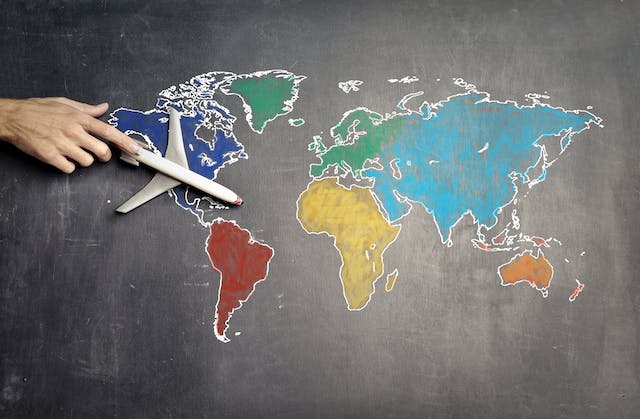For centuries, people from various places have traded goods across borders. This exchange, known as “globalization,” has evolved from ancient times, like the Silk Roads, to recent trade pacts such as NAFTA. Globalization is about more than just trading stuff. It involves how countries, businesses, and people around the world connect and work together. In this article, we will look at how globalization works, including its pros and cons.
Imagine a world where products from one country are sold in many others. That’s globalization in action! It’s not just about buying and selling; it’s also about sharing ideas, cultures, and technologies.
Globalization happens in many ways. One is through international trade agreements, like NAFTA, where countries agree to make it easier to trade with each other. Another way is through technology, like the internet, which lets people connect instantly across continents.
But globalization isn’t without challenges. It can affect jobs, cultures, and the environment. Some worry it might benefit some countries more than others.
Understanding how globalization works involves exploring its impact on economies, societies, and the world as a whole. It’s like uncovering a big puzzle that connects all of us around the globe.

What is Globalization?
Globalization refers to the connections between countries all around the world through trade and investments. It’s like a giant web linking economies together. While globalization has been around for a really long time, the way we see it today started in the 1800s. This shift happened during the Industrial Revolution when things like trains, steamships, and the telegraph came along. These inventions made it easier for countries to work together economically.
But not everyone is a fan of globalization. Some countries prefer protectionism, which means they want to shield their own businesses from competition abroad. They do this by putting up barriers to trade, like taxes on imported goods.
Globalization isn’t just about buying and selling stuff. It’s also about sharing ideas and working together on big projects. Sometimes it’s great because it can bring more options and lower prices for things we want. Other times, it’s tough because it can make it hard for local businesses to compete. Both globalization and protectionism have their pros and cons, and countries often debate which approach is best for their economy.
Three Instances Illustrating Globalization
Globalization refers to how countries around the world are connected and work together. Here are three examples that show how globalization works and how this connection happens:
- Intergovernmental Organizations: Globalization works by enabling the creation of international organizations through agreements between many countries. For instance, the European Union, the United Nations, the World Bank, the World Trade Organization (WTO), and the International Monetary Fund (IMF) are examples of such organizations. They work on global issues like trade, finance, and peacekeeping.
- Intergovernmental Treaties: Many countries sign treaties or trade policies to encourage international trade and investment. These agreements, known as free-trade agreements, make trade easier. Examples include the North American Free Trade Agreement (NAFTA) and the Comprehensive Economic and Trade Agreement (CETA).
- Multinational Corporations: These are companies that operate in many countries. Globalization allows these corporations to do business worldwide. For example, major US corporations can sell their products in Mexico, Europe, and China because of globalization.
These examples illustrate how globalization impacts international relations, trade, and business across the globe, creating interconnectedness between nations.
Advantages of Globalization and Its Impact on Economies
Globalization offers numerous advantages to a country’s economy. It’s not just about goods moving around the world—it’s about how it shapes economies and people’s lives.
One significant benefit is its boost to economic growth. When countries participate in the global economy by trading goods, sharing technology, and exchanging information, it leads to overall economic development. This growth translates into improved living standards, higher incomes, increased wealth, and often, a reduction in poverty levels, enhancing the well-being of the entire nation.
Moreover, globalization makes production more cost-effective. Businesses gain access to a broader market, which means they can produce goods more efficiently and at varying price ranges, catering to diverse consumer needs.
Another aspect is the promotion of collaboration. When nations engage in global trade and investments, they rely on each other for specific goods and services. This interdependence fosters cooperation and mutual support among countries.
Furthermore, globalization brings opportunities to less affluent nations. Companies can shift their production from high-cost regions to countries with lower production expenses, bringing employment, technological advancements, and economic prospects to places with limited resources.
In essence, globalization is not just about trade; it’s a catalyst for economic growth, cooperation, and equitable opportunities across the globe.
Disadvantages of Globalization And Its Impacts on the Economy
Globalization, the interconnectedness of economies worldwide, brings both benefits and drawbacks. While it fosters economic growth, it also poses challenges:
1. Uneven Economic Development: Globalization boosts economies but favours richer nations over developing ones. This imbalance means that wealthier countries reap more significant benefits, leaving developing nations behind.
2. Decline of Local Businesses: Policies promoting globalization often advantage large corporations with vast resources, overshadowing smaller local businesses. For example, a neighbourhood burger joint might struggle against a multinational burger giant that leverages global supply chains for competitive pricing.
3. Heightened Risk of Global Recessions: Interdependent economies can trigger widespread economic downturns. If one country faces financial turmoil, it can set off a chain reaction affecting numerous nations simultaneously, potentially culminating in a global financial crisis.
4. Exploitation of Cheap Labor: Globalization allows companies to tap into cheaper labour markets in developing countries, fostering job opportunities there. However, this doesn’t always translate to robust economic growth in those regions.
5. Job Displacement: Rather than creating more jobs, globalization shifts them from high-cost countries to lower-cost ones. This leads to job losses in high-cost regions as production moves overseas, impacting local employment.
Overall, while globalization drives global integration and economic expansion, its downsides highlight the need for balanced policies that consider the interests of both developed and developing economies.

Leave a Reply